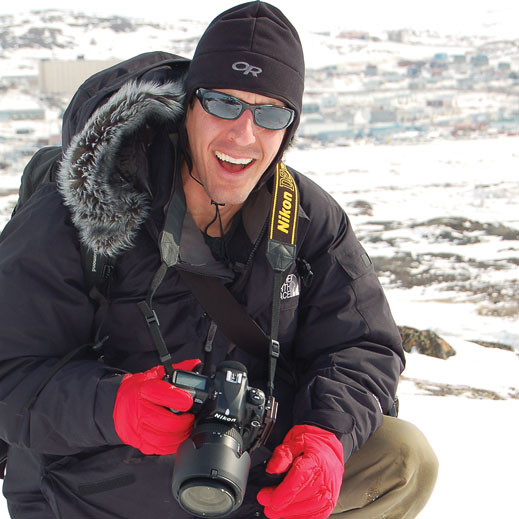Growing up in Wisconsin, Chris Linder devoured stories about Jacques Cousteau, Robert Peary, and others who ventured into forbidding environments seeking knowledge.

Eager to follow their example, Linder earned a BS in oceanography from the U.S. Naval Academy and an SM in ocean engineering from the MIT–Woods Hole Oceanographic Institution Joint Program. Along the way, he discovered a talent for photography and visual storytelling that’s helped him build a worldwide reputation as a documentarian of field research in far-flung places.
Linder’s spectacular photography is featured in books including his 2011 Science on Ice: Four Polar Expeditions as well as in magazines, films, museum exhibits, and interactive educational programs. His independent assignments have included sea ice and phytoplankton research aboard icebreaking ships in the Arctic, river water analysis from dugout canoes in Africa, and multidisciplinary studies on the release of carbon and other nutrients from thawing permafrost in the remote Kolyma River watershed in Siberia. (See his work online at www.chrislinder.com.)
“To me, science is more than numbers on a spreadsheet,” he says. “By photographing scientists at work in the field, I aim to show how creative thinking and resourceful problem-solving are essential to discovery.”
Linder’s images offer natural beauty, like delicate crystals on sea ice or penguins in an Antarctic storm. Yet the nitty-gritty of research and the intense focus of men and women on difficult missions are never far away, and Linder’s training provides a special perspective. “As a former scientist, I understand the difficult process of conducting fieldwork,” he says. “You have to have an idea, secure funding, assemble a team, get to the field site, get your equipment to work. When I cover an expedition—sometimes for weeks—I try to portray every aspect of the scientific process. The full story has more power than any single image.”
Essential mentoring came from WHOI senior scientist Glen G. Gawarkiewicz ’81, who was one of his thesis advisors; when Linder joined WHOI as a technician after three years of service as a Navy meteorologist, Gawarkiewicz became his supervisor. “Glen is very keen on public education about science; I had just picked up a camera, and he encouraged me,” recalls Linder. He also credits WHOI senior scientist Robert Pickart, PhD ’87, who hired Linder to document a 2002 Arctic expedition.
When not traveling, Linder lives in Seattle with his wife, pathologist Meghan Delaney, and children Eva, six, and Ian, two. They enjoy camping, and Linder runs or bikes daily.
Keep Reading
Most Popular
Large language models can do jaw-dropping things. But nobody knows exactly why.
And that's a problem. Figuring it out is one of the biggest scientific puzzles of our time and a crucial step towards controlling more powerful future models.
How scientists traced a mysterious covid case back to six toilets
When wastewater surveillance turns into a hunt for a single infected individual, the ethics get tricky.
The problem with plug-in hybrids? Their drivers.
Plug-in hybrids are often sold as a transition to EVs, but new data from Europe shows we’re still underestimating the emissions they produce.
Google DeepMind’s new generative model makes Super Mario–like games from scratch
Genie learns how to control games by watching hours and hours of video. It could help train next-gen robots too.
Stay connected
Get the latest updates from
MIT Technology Review
Discover special offers, top stories, upcoming events, and more.